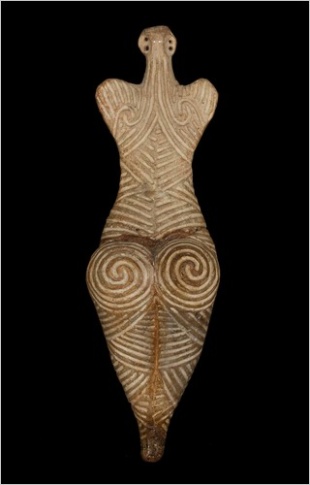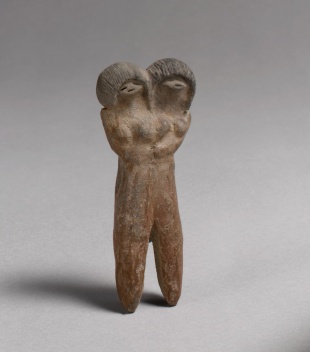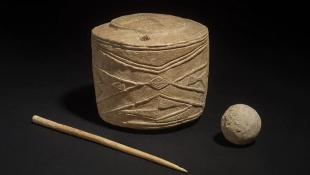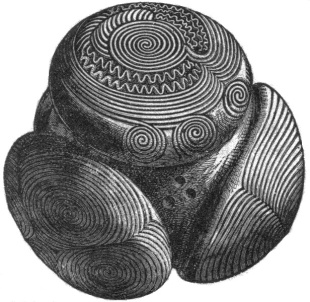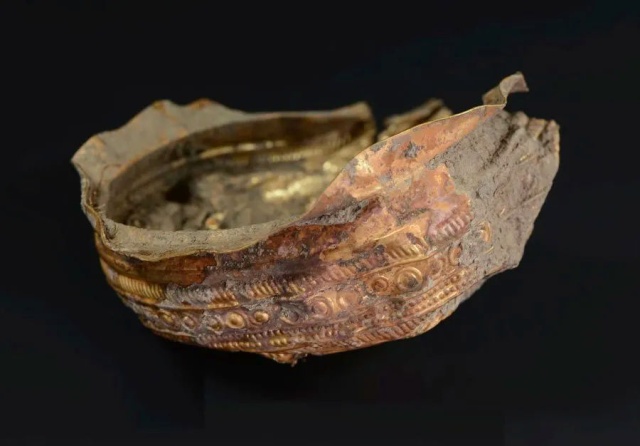NEOLITHIC ART AND SYMBOLS
The Neolithic, or late Stone Age, period was not a time of great cave painting like those produced 17,000 years ago in Lascaux Cave and 35,000 years ago in Chauvet’s Cave in France and 40,000 years ago in Sulawesi and Borneo in present-day Indonesia. The art produced in the Neolithic era was more minimal and modest — figurines, engravings, ceramics and mysterious symbols and stone balls.
French prehistorian Jacques Caurvin has argued that the invention of agriculture was preceded by a “revolution of symbols.” In the 1970s, he led a team that was excavating an area in Mureynbey in southern Syria, one of the places it is said agriculture first began. Under the layers of sediment that corresponded with the first agriculture he found layers with wild bull horns and female figurines, leading him to conclude that symbols preceded agriculture.
Surveys of European sites by archaeologist Ian Hodder led him to conclude the same thing. At the sites he investigated he found many representations of death and wild animals and theorized that they were attempts by humans to overcome their fear of wild nature. By placing the representations in caves and dwellings, he theorized, they were somehow pacified.
Body adornment appeared to have been practiced in the Stone Age. Lots of jewelry and beads from the period have been found. Neolithic farmers adorned their faces with tattoos of blue tridents. The oldest known tattoo is on Otzi, the Iceman Archaeologists have unearthed palettes for grinding and mixing face powder and eye paint dating to 6000 B.C. There is evidence that men shaved as far back as 20,000 years ago. There are cave drawings with beardless men, Sharpened flints and shells have been found in graves that may have been used as razors.
A mysterious eight meter-wide engraving — composed of cross-hatching lines carved into a cave wall — dated to be between 3,000 and 5,000 years old was discovered in a cave in Spain according to a March 17 news release from the Catalan Institute of Human Paleoecology and Social Evolution. Although it doesn’t look so impressive experts called it one of the most important Neolithic compositions ever found in the Mediterranean area. Speleologists stumbled across the art work cave, located in northeastern Spain, in 2021 after passing through a small holeinto an oval-shaped chamber about 93 square meters (1,000 square feet) in size. According to the Miami Herald: The art appears to feature animals, stars and an idol, researchers said. The figures were likely carved using a stone or wooden tool, though some may have been made exclusively by hand. The animals, potentially representations of horses or cattle, appear at the bottom of the mural and the night sky appears at the top, indicating symbolic meaning, not random composition, researchers said.[Source: Brendan Rascius, Miami Herald, March 21, 2023]
RELATED ARTICLES:
EARLY CAVE ART europe.factsanddetails.com ;
WHY EARLY HUMANS MADE ART factsanddetails.com ;
HOW EARLY HUMANS MADE ART: METHODS, MATERIALS AND INTOXICATION europe.factsanddetails.com ;
IMAGES IN EARLY MODERN HUMAN ART: ANIMALS, HAND PRINTS, FIGURES europe.factsanddetails.com ;
EARLY HUMANS IN SULAWESI, INDONESIA AND THEIR 45,000-YEAR-OLD CAVE ART factsanddetails.com ;
EARLY HUMANS IN BORNEO: NIAH CAVES 40,000-YEAR-OLD ROCK ART factsanddetails.com
CAVE ART IN SPAIN europe.factsanddetails.com ;
CAVE ART IN FRANCE europe.factsanddetails.com ;
LASCAUX CAVE europe.factsanddetails.com ;
CHAUVET CAVE: PAINTINGS, IMAGES, SPIRITUALITY europe.factsanddetails.com ;
WORLD'S OLDEST SCULPTURES factsanddetails.com ;
VENUS STATUES europe.factsanddetails.com ;
WORLD'S OLDEST POTTERY europe.factsanddetails.com ;
WORLD'S OLDEST MUSIC: FLUTES, NEANDERTHALS. LITHOSPHONES europe.factsanddetails.com
Good Websites Archaeology News Report archaeologynewsreport.blogspot.com ; Anthropology.net anthropology.net : archaeologica.org archaeologica.org ; Archaeology in Europe archeurope.com ; Archaeology magazine archaeology.org ; HeritageDaily heritagedaily.com; Livescience livescience.com/
RECOMMENDED BOOKS:
“Prehistoric Art: The Symbolic Journey of Humankind” by Randall White (2003) Amazon.com;
“The Cambridge Illustrated History of Prehistoric Art” (Cambridge Illustrated Histories)
by Paul G. Bahn and Desmond Morris (1998) Amazon.com;
“Sha'ar Hagolan: Neolithic Art in Context” by M. Miller, Yosef Garfinkel, et al. (2002) Amazon.com;
“Prehistoric Art in Europe” by N. K. Sandars (1992) Amazon.com;
“Images of the Ice Age” by Paul G. Bahn Amazon.com;
“The First Artists: In Search of the World's Oldest Art” by Paul Bahn (2017) Amazon.com;
“Inside the Neolithic Mind” by David Lewis-Williams (2005) Amazon.com;
“What Is Paleolithic Art?: Cave Paintings and the Dawn of Human Creativity” by Jean Clottes Amazon.com;
“The Nature of Paleolithic Art” by R. Dale Guthrie (2005) Amazon.com;
Late Stone Age Sculpture
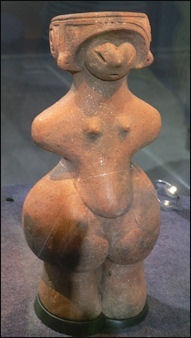
Dogu from Japan
The national Museum in Bucharest contains wonderful 5000-year-old fertility goddesses made from baked clay. The plump headless figures resemble abstract version of the robot from "Lost in Space" but the have a small line for the vulva and folds for fat. Dogu were statues created in Japan thought to have been prayer figures used in prayers for prosperity and fertility. There are different types. Some female dogu have big butts and hips. Others have babies in their arms. Many are nude and pregnant. Some male dogu have heavy beards and big chests. Dogu faces are remarkably varied. Many have different expressions depending on the angle from which they are viewed.
Dogu were shaped and decorated using sticks and rope. Their designs and the situations in which they were found vary a great deal leading some to speculate that there were animism symbols, funeral objects or healing dolls. Similar ceramic figures were created in Europe and western Asia in the new Stone Age (8,300 to 5,000 B.C.) as Earth Mother figures associated with agriculture. Dogu are not associated with agriculture because they appeared in Japan before agriculture did.
Tokyo National Museum curator Yoichi Inoue told the Daily Yomiuri, “The dogu’s designs emphasized body parts that weren’t part of the male form, such as the organs needed in giving birth, showing us that those people weren’t interested in the mysteries of life. They are prayers for a safe delivery. Fertility leads to prosperity in tribes and eventually brings productiveness and prosperity in society.” More than 18,000 dogu figures have been unearthed throughout Japan. More than 2,000 dogu have been unearthed in Iwate Prefecture; so many that a guidebook on them has been published. The British Museum possesses a number of dogu and has hosted a dogu exhibition.
See Separate Article: DOGU, STONE CIRCLES AND JOMON ART AND CRAFTS factsanddetails.com
Neolithic Female and Whalebone Figurines
Archaeology magazine reported: Inside a kiln whose roof had collapsed, archaeologists excavating at the site of Villers-Carbonnel on the banks of the Somme River in northern France, uncovered a rare terracotta female figurine. According to project archaeologist Françoise Bostyn, the discovery is exceptional due to both the completeness and rarity of this type of female representation at Middle Neolithic sites. Bostyn believes that the figurine, which shows evidence of burning, broke into pieces during firing. [Source: Jarrett A. Lobell, Archaeology magazine, March-April 2012]
It is likely that her team was able to recover all the fragments because the object was never removed from the kiln. The figurine, which measures just over 16 centimeters (eight inches) long, was created by the Chassey culture, named for the site where evidence of the culture was originally found. The Chassey culture flourished in central and southern France between 4200 and 3600 b.c. Similar figurines have been found at other Chassey sites. According to Bostyn, the stylistic unity of these female representations probably reflects some sort of shared ideology and can be considered a mark of the cultural identity of the Chassey people.
A 5,000-year-old whalebone figurine was discovered at the Skara Brae archaeological site, in the Orkney Islands of northern Scotland, in the 1850s. According to Live Science: It is one of the oldest artistic representations of a human figure ever found in Britain. The figurine was part of a private collection in the 1860s, but its whereabouts were unknown for more than 150 years, until it was rediscovered in April, 2016 of this year in a box at the Stromness Museum, in the town of Stromness in the Orkneys. The figurine has been dubbed "Buddo," from the Orkney word for "friend." It is one of only eight Neolithic human figurines ever found in Britain: four figurines have been found in the Orkneys, and the others were discovered in southern England. [Source: Tom Metcalfe, Live Science June 22, 2016]
The Skara Brae Buddo was found on the floor of a bed compartment in "House 3" at the Skara Brae site, along with several other small objects. Archaeologist David Clarke, who rediscovered the Buddo figurine this year, thinks it may have been left behind on purpose, as part of a ritual when the inhabitants abandoned the village. The Buddo is carved from what is thought to be a whalebone vertebrae. A hole runs through the head of the figurine from ear to ear, which may have been used to hang it up. Clarke thinks another hole in the base may have been used to separately attach legs to the figurine. In 2009, archaeologists excavating the Links of Noltland site, on the island of Westray in the Orkneys, reported the discovery of three Neolithic figurines that have become known as the "Westray Wives." This image shows the largest of the Westray figurines, measuring around 1.6 inches (4 centimeters) in height and carved from sandstone. Archaeologists think this figurine is slightly older than the Skara Brae Buddo.
9000-Year-Old Other Worldly Figures From Ain Ghazal, Jordan

Ain Ghazal heads from Jordan
Mysterious human figures unearthed at Ain Ghazal, are among the oldest human statues ever found. Made of lime plaster and dating back to 7000 B.C., the figures are about 3½ feet tall and have bitumen accented eyes and look like aliens from outer space. Scholars believe they played a ceremonial role and may have been images of gods or heros.
The figures were discovered 1985 by the driver of a bulldozers clearing the way for a road. The statues were made of delicate materials—so delicate they whole site was unearthed and shipped to a Smithsonian laboratory where it took ten years to assemble the figures.
The figures come in two types: full figures and busts. Both types were made by forming plaster over a skeleton made of bundles of reed wrapped in twine. Facial features were probably made by hand with simple tools made of bone, wood or stone. The plaster technology that was used was fairly advanced and required heating limestone to temperatures of 600̊ to 900̊C
Archeologists working in Ain Ghazal found what they say may be the world’s oldest known game. The game board, a limestone slab, has two sets of circular depressions and bears a striking resemblance to games played in the Middle East today with counting stones. The slab was found in a house, and because it seemed to serve no utilitarian or ceremonial function archeologists concluded it most likely was a game board. [National Geographic Geographica, February 1990].
8000-Year-Old Jewelry and Female Figurines from Serbia
In 2012, Science Daily reported: “Archeologists from the University of Tübingen’s Institute of Prehistory are working with the Serbian Archeological Institute in Belgrade to analyze the most comprehensive Early Neolithic hoard ever found. Work on the nearly 8000 year old collection of jewelry and figurines is funded by the Thyssen Foundation. [Source: sciencedaily.com, November 6, 2012 +/]
“The unique hoard is composed of some 80 objects made of stone, clay and bone. “This collection from Belica, in all its completeness, provides a unique glimpse into the symbols of the earliest farmers and herdsmen in Europe,” says Tübingen archeologist Dr. Raiko Krauss, who heads the German side of the project. +/
“The objects include stylized female figures, parts of the human body, as well as miniature axes and abstract figures. Much attention has been given to the rotund female figures of water-smoothed stone given human features by human hands. Were they idols, lucky charms or fertility symbols? Their purpose is unknown. The stone objects are mainly of serpentinite from an ophiolite belt running some 40 kilometers west of the Belica site. The rock was washed out of the mountains and worn smooth by rivers and streams. Neolithic artists then selected the pebbles they wanted from the valleys. +/
“Archeologists mapped the outline of an Early Neolithic settlement in June of this year using the distribution of finds on the surface as a guide. In the middle, they found the largely undisturbed hoard. Using modern geophysical prospection methods, they were able to bring buried parts of the settlement to light during summer excavations. “Important finds like this should be prominently displayed in the Serbian National Museum,” says Krauss of the hoard. “But the National Museum in Belgrade has been closed since the civil war.” So Krauss is working with his Serbian colleagues on an exhibition at the University of Tübingen Museum in Hohentübingen Castle. The modern world will first get to see the Belica hoard there in the winter semester of 2013/14. The hoard, and the results of the current investigation, are to be published in German and Serbian.” +/
7100-Year-Old Well in Germany Yields All Kinds of Stuff
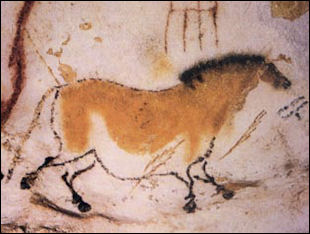
Lascaux cave art was made before the Neolithic EraChris Catling wrote in world-archaeology.com: “Thanks to preservation under waterlogged conditions, a well in the federal state of Saxony, Germany, has revealed unprecedented information about woodworking skills, diet, and ritual in early Neolithic Europe. Found in early 2008 at Altscherbitz, during construction work on the Leipzig/Halle airport, the well was carefully isolated and extracted from the ground in one block for excavation under laboratory conditions under the direction of Rengert Elburg of the Saxony State Office of Archaeology. [Source: Chris Catling, world-archaeology.com, September 6, 2010 /*/]
“Heavy oak timbers were used to line the well, held together by mortise and tenon joints secured by wedges, the first time this type of keyed tenon joint has been recorded for the early Neolithic. On one piece of wood, the last ring under the bark was present and this allowed the felling of the trees to be dated precisely to the winter of 5102-5101 B.C. /*/
“Complete ears of emmer wheat (Triticum dicoccum) and einkorn (Triticum monococcum) were found in the base sediment, as well as fruits of the bladder cherry or Chinese lantern (Physalis alkekengi) and several complete rose hips, some of them still as red as the day they were picked over 7,000 years ago. Cultivated wheat, barley, peas, lentils, linseed, and poppy seed were all present, as well as weeds associated with human habitation and cultivation, including large quantities of henbane (Hyoscyamus niger), the poisonous solanaceous plant used in very small doses for its hallucinogenic properties.
“At some stage the well shaft was deliberately filled with a rich mix of pottery, stone and bone tools, bark containers and numerous fragments of string and rope, all mixed in with layers of twigs. Above these layers, a pot was placed, formally closing the well. /*/
“This was clearly a vessel of some significance, Rengert Elburg says. Extensive damage to the exterior suggests that it started life as a heavily used domestic pot, with a very slight incised decoration, typical of Linear Pottery Culture. When it broke in two it was mended by gluing the halves together with pitch. The repair was reinforced by binding the two halves together through holes drilled on either side of the break. Then the outside surface of the pot was completely redecorated by covering it with a thin layer of pitch into which narrow strips of birch-bark were stuck in a design completely unrelated to the incised pattern underneath. Traces of wear on the base suggest that the pot continued in use with this new decoration for some considerable time before being carefully placed in the well.” /*/
Do 6,800-Year-Old, Romanian, Ceramic Female Figurines Have Signs of Tattooing?
On the fifth millennium B.C. ceramic female figurines from the Cucuteni culture in present-day Romania, Archaeology magazine reported:In 1981, more than 20 ceramic human figurines reclining on chairs and bearing elaborate incised decorations were unearthed in northeastern Romania. They, and many other figurines like them — such as the one pictured at right — were made by a people we know today as the Cucuteni culture, which lasted from 4800 to 3000 B.C. in what is now Romania and Ukraine. [Source: Archaeology magazine, November-December 2013]
Some scholars have interpreted these lines as representations of body modification. “They could be tattoos,” says San Francisco State University archaeologist Douglass W. Bailey. “Some say they are clothes, or they could represent something else we don’t understand. We will never know for sure, but in a sense, that’s unimportant. What’s important is that they were using the surface of their bodies to communicate ideas, whether they related to membership in a group or individual identity.” He notes that earlier Paleolithic figurines such as the Venus of Willendorf were unmarked, and that incisions on the bodies of figurines only appear after the beginning of the Neolithic, when ceramics were first made and decorated.
“In the Neolithic, people were incising pots by taking a sharp point and cutting away the clay,” says Bailey. “If the pot was a metaphor for the body, that process of engraving could have also been seen as tattooing.” While the practice might have existed in Paleolithic times, there is no evidence for tattooing before 7,000 years ago. Perhaps it was only after the first pots were decorated that people began to contemplate making permanent changes to their own skin’s appearance.

Early Neolithic pottery, figurines and house models from Tumba and Veluška Tumba at Porodin in Pelagonia in North Macedonia: 1). height: 48 centimeters; 2) width 23 centimeters; 3. height: 17 centimeters; 4) height: 7 centimeters; 5) height: 12 centimeters 6) height: 6 centimeters 8) height: 25 centimeters
6000-Year-Old Valdivia Figurines in Ecuador
Around 4000–3500 B.C., ancient people living along the coast of Ecuador produced the earliest representational images in the Americas. Small, solid figures of carved stone, between three and five inches high, have been found at archaeological sites like Real Alto and Loma Alta. Made from calcium carbonate (includes limestone, marble, gypsum, etc.), these tiny figurines ranged from simple ground plaques to finely carved statuettes with clearly delineated facial features. The figurines often possessed both feminine and masculine attributes, such as the breasts of a woman and the genitals of a man. [Source: Department of Arts of Africa, Oceania, and the Americas, The Metropolitan Museum of Art, metmuseum.org October 2004 \^/]
“Roughly 500 years later, the first ceramic figurines began to appear at Real Alto. While similar in form to their stone predecessors, these fired clay figures varied significantly in detail. They were constructed of two rods of clay pressed together to form the main portion of the figure, and the hair—often elaborately styled—was added as a separate caplike slab of clay. The arms of the figures are indicated only slightly and the legs are separated by a triangular cut. Most of the ceramic figurines appear to be female, with prominent breasts and voluptuous bodies, though some of the statuettes continued to manifest both male and female characteristics. \^/
“Validivia figurines have been found in a variety of contexts at Real Alto, from burials of important personages to refuse piles on house floors. The majority of them, however, have been found near hearths and food preparation areas—activities traditionally associated with women. Based upon these features, the figurines are most often interpreted as fertility figures, though their precise purpose remains unknown.” \^/
5000-Year-Old Cerro Sechin Sculptures in Peru
According to the Metropolitan Museum of Art: “One of the most ancient monumental sites in Peru, Cerro Sechin is located in the Casma Valley, 168 miles north of Lima. The site is best known for its megalithic architecture and engraved stone slabs, which depict graphic scenes of human sacrifice and death. Cerro Sechin is part of a larger group of sites known as the Sechin Complex, a group of contemporaneous settlements in the Casma Valley that exhibit similar monumental public and ceremonial architecture, and which practiced small-scale irrigation agriculture. [Source: Nicole Slovak, Department of Anthropological Studies, Stanford University Metropolitan Museum of Art, metmuseum.org, October 2003 \^/]
“Inhabited for much of the second millennium B.C., Cerro Sechin has been the most intensively studied site in the Sechin Complex. It covers roughly 50,000 meters squared and consists of a quadrangular three-tiered stepped platform flanked on each side by two smaller buildings. The platform was constructed in several stages using conical adobes, or large sun-dried bricks with broad circular bases and tapered points, which were then set into clay mortar and plastered over to form wall surfaces. A retaining wall, roughly 4.15 meters (13.5 feet) tall and containing nearly 400 granite sculptures, was added relatively late in the site's history and encircled the perimeter of the building. The stone sculptures, undoubtedly the most famous feature at Cerro Sechin, depict a possible mythological or historical scene in which a procession of armed men, probably important personages or warriors, make their way among the mutilated remains of human victims. Given the gruesome nature of the stone frieze, it seems likely that some degree of warfare, violence, and/or raiding existed among these early valley peoples. \^/
“The elaborate and grim stone frieze at Cerro Sechin has fascinated scholars and laypeople alike since its discovery in 1937. Made from locally obtained blocks of granite, the stone monoliths depict scenes of sacrifice and bodily mutilation. Images of important personages, each of whom carries a club or staff and wears a loincloth and hat, are surrounded by engraved depictions of severed body parts and naked, maimed human beings. The majority of important personages are carved on larger stones, approximately 3 x 1 meters, while the dismembered human remains are carved into much smaller pieces of stone ranging from 0.5 to 1.2 meters wide and 0.5 to 0.8 meters long. Some scholars suggest that the monoliths were intended to commemorate an important battle or conquest, while others propose that the engravings were associated with religious and mythical themes. [Source: Nicole Slovak, Department of Anthropological Studies, Stanford University, Metropolitan Museum of Art, metmuseum.org, October 2003 \^/]
“Of the hundreds of monoliths found at Cerro Sechin, 244 contain or represent faces. The faces belong to either important persons, mutilated beings, or severed heads. While the facial expressions of the important personages are fierce and determined, those of the mutilated individuals and severed heads are contorted in pain. Their eyes, often indicated by a solitary curved line or as bulging circles, may indicate death, struggle, or disfigurement. The mouth—the most accentuated aspect of the face—is often pulled back in a distorted grimace, and streams of blood flow from head wounds. In other instances, whole figures have been splayed down the center and their inner intestines graphically depicted. While evidence for large-scale warfare during the second millennium B.C. is scant for this region of Peru, it seems clear that notions of violence and combat were present, perhaps even celebrated, at Cerro Sechin.” \^/
Chalk Drum Found at the Grave of Three 5,000-Year-Old “Cuddling” Children
In 2022, six years after its discovery, a 5000-year-old chalk drum — found at a children's burial site and described as the "most important piece of prehistoric art" found in Britain in a century — was put on display at the British Museum. The burial date back to about the same time that construction of Stonehenge started, [Source: Joshua Zitser, Business Insider, February 13, 2022; Owen Jarus, Live Science, February 22, 2022]
According to Business Insider: “The drum was found on a country estate near the village of Burton Agnes in East Yorkshire, in 2015 when a routine excavation had to be carried out so the owners could erect a structure, The Washington Post reported. During the excavation, a team of archaeologists with the independent company Allen Archaeology found the burial site. Within the burial site were the remains of three children, 3 to 5, 6 to 9, and 10 to 12 years of age when they died., whose bones had been intertwined for millennia. "They were cuddling," Mark Allen, the founder of Allen Archaeology, told the Washington Post and Live Science . The two youngest children were found "facing towards each other and possibly holding hands." The eldest child was between and had their arms around the two youngest "as if protecting them,"
“The drum was placed above the head of the eldest child, along with a chalk ball and a polished bone pin, per science news aggregator Phys.org. Archeologists do not believe the drum was used as a musical instrument despite the name. It was more likely a piece of sculptural art, a talisman, or, perhaps, a toy for the children. The grave is a rare find, according to the Washington Post, because ancient people in neolithic Britain would usually leave bodies for cremation or to be eaten by crows.
And the drum is so significant because it is "one of the most elaborately decorated objects of this period found anywhere in Britain and Ireland," the British Museum said. The carvings on the drum, which show spirals and triangles, feature a "butterfly" motif, British Museum curator Neil Wilkin told The Washington Post. "The motifs themselves are abstract but may convey symbolism or religious principles that have yet to be deciphered," the British Museum statement said. They are artistically similar to other objects found at neolithic sites in Scotland and Ireland, Wilkin said, suggesting that prehistoric communities were in communication with each other despite significant geographical distances. "This drum is particularly intriguing, because it basically encompasses a sort of artistic language that we see throughout the British Isles at this time, and we're talking 5,000 years ago," project curator Jennifer Wexler told CNN.
The sculpture was also found within an archaeological context, meaning that the artifacts and human remains found with the sculpture were recorded in detail. "We know of a number of highly decorated objects — such as stone and antler maceheads, carved stone balls — of Middle Neolithic date [around 3400-3000 B.C.] from Britain and Ireland, but it is rare to find them in a good archaeological context," Joshua Pollard, an archaeology professor at the University of Southampton, said. Because of this, the relationship between the sculpture and the buried children can be examined in detail, said Pollard, noting that one possibility is that the sculpture could have been a protective force, acting as a "guardian" of sorts.
The discovery comes more than 100 years since the unearthing of the Folkton Drums. Three similar chalk drums were found in the village of Folkton — around 15 miles from Burton Agnes — in 1889. Wilkin told The Washington Post, "We've been waiting for over 100 years for another one of these amazing objects to come up, and for it to come up with children — again — is astonishing."
Mysterious 5,000-Year-Old Stone Balls in Scotland and the Orkney Islands
Hundreds of baseball-size stone balls have been found at Neolithic sites mainly in Scotland and the Orkney Islands, but also in England, Ireland and Norway. Some are ornately carved — such as the famous Towie ball discovered in northeast Scotland in 1860 — but others are studded with projections or smoothly polished. According to Live Science: Early researchers suggested that the balls were used as weapons, and so they were sometimes called "mace heads" as a result. Another idea is that rope could have been wound around the lobes carved into some of the balls to throw them. But most archaeologists now think the stone balls were made mainly for artistic purposes, perhaps to signify a person's status in their community or to commemorate an important phase of their lives, said archaeologist Vicki Cummings of the University of Central Lancashire in England, who led the excavations of the tomb on Sanday. [Source: Tom Metcalfe, Live Science, September 16, 2021; Live Science, June 19, 2018]
Modern archaeologists have determined that the stone balls were created during the Neolithic period around 5,000 years ago, when ancient monuments like this stone circle in Scotland were built. The intricate spiral and circular patterns chipped into three of its four carved lobes on one ball are among the finest examples of Neolithic art. Spirals like the patterns carved into the Towie ball are a common motif in Neolithic art in many parts of Europe. Archaeologist who have studied the carved stone balls from Skara Brae and other Neolithic sites on the Orkneys say they show a characteristic local style, with more pyramidal or pointed projections compared with other stone balls.
The two stone balls found at the tomb near the beach at Tresness on Sanday — one made of black stone and the other of lighter-colored limestone — are very early examples of such objects and were smoothly polished, rather than being carved like the Towie ball. Carving balls tended to happen later in the Neolithic period, she said, while polishing balls was generally an earlier practice. The two polished balls "are much simpler, but they are still beautiful objects," Cummings told Live Science. "They would have taken quite a long time to make, because it is quite time-consuming to polish a stone … You've got to sit there with some sand and some water and a stone, and basically put the work in."
The tomb where the balls were found was built about 5,500 years ago when the coast was much further away. This is one of the few times that stone balls have been found in their true archaeological context, Cummings said, which could shed light on the purpose of the mysterious objects. Each of the balls were found in the corners of two different compartments used to inter human remains in the burial chamber of the tomb, while other objects — especially pieces of pottery — were found along the compartment walls. "Probably what was happening was that people were putting little slabs down and putting pots on top of these slabs," Cummings said. "They really seemed to be interested in the walls and the corners."
Inside the tomb, archeologists also found a deposit of cremated human bones near the entrances of two of the five compartments in the burial chamber, as well as several "scale knives," which were made by breaking beach pebbles into flakes that had a sharp edge. "You can use it as a really good butchery tool — and we found tons of those in the [tomb], which is really surprising. And that begs the question of what they [the makers] were up to," Cummings said. People may have used the knives to separate flesh from the bones of the dead. "It might suggest they were manipulating the human remains that were placed in the chamber — there are many traditions and lots of examples of that," she said.
Golden Cups and Sun Bowls Found in Europe
In 2012, archaeologists have dated a rare golden cup uearthed near the town of Montecchio Emilia in Northern Italy to about 1800 B.C., making it one of only three other similar golden cups discovered in Europe and Britain. According to Popular Archaeology: “The cup turned up during a survey of a gravel pit located along terraces adjacent to the Enza River. Previous surveys in nearby areas also revealed evidence of dwellings of the late-Neolithic and Bronze Ages (IV-III millennium B.C), terramara cremation urns from the mid-recent Bronze Age (XIV-XII centuries B.C.), and Etruscan graves. [Source: Popular Archaeology, October26, 2012 ||~||]
“A recent report stated that “It had clearly been lifted up and partially moved by the plough quite some time ago. No structure, tomb or anything else that could be correlated to the original resting place of the cup was found: evidently, it must have been buried in a simple hole in the bare earth. It appears to have been smashed in ancient times, then later partially broken by a plough, which seems to have pulled out a small piece”. ||~||
“Archaeologists suggest that it might have served as a ritual cup, but the difficulty of its context when found has left archaeologists puzzled about the use, meaning and owners of the vessel. As reported, “No other elements – from strictly the same period as the Montecchio cup – were found in the gravel pit area: it thus must have been hidden away or placed there as a votive offering, although some information from the archives, presently under examination, might be able to link the cup to a finding of 13 gold objects, apparently from the Bronze Age, when a field in Montecchio was ploughed on January 18, 1782: unfortunately, the items were melted down. All that remains are lively descriptions from the period”. ||~||
Regarding the three other similar cups found in previous investigations, one was discovered in Fritzdorf, Germany in 1954 and is currently exhibited at the Landesmuseum in Bonn, Germany. The other two are exhibited at the British Museum and were found, respectively, in Rillaton (Cornwall) and Ringlemore (Kent) in the U.K. The U.K. cups differed from the Italian and German cups in that they featured a corrugated external surface. It is thought that there could be a trade system relationship that links the cups. According to Dr. Filippo Maria Gambari, Superintendent of the Archaeological Heritage of Emilia Romagna, “this find ideally links this area of Italy with the henges of the United Kingdom and the area of North Rhine-Westphalia (Germany)”. ||~||
According to Live Science: Archaeologists excavating a 3,000-year-old settlement in Austria have unearthed a golden bowl with the image of a sun adorning its underside. "At the bottom of the bowl, a sun disc with 11 rays is depicted," Michał Sip, an archaeologist with the German company Novetus, who is leading excavations at the site, told Live Science in an email. The artisan (or artisans) who crafted the bowl also included a "circular motif [images] of circles and dots" decorating the bowl's exterior, Sip said. The fragile bowl was shaped out of gold sheet metal, and it "probably had a cultic function," Sip added. [Source: Owen Jarus, Live Science, October 14, 2021]
Archaeologists know of about 30 similar bowls from ancient Europe, but "this is the first find of this type in Austria, and the second to the east of the alpine line," Sip told Science in Poland. These bowls were produced in the regions of what is now Germany, Scandinavia and Denmark, he noted.At nearly 8 inches (20 centimeters) in diameter, the bowl is slightly larger than a person's hand. But it's very shallow — just 2 inches (5 cm) tall. An analysis revealed that the vessel is about 90 percent gold, 5 percent silver and 5 percent copper, and researchers are now hoping to discover where its raw materials originated, according to Science in Poland.
Green Stone Jewelry, Dogtooth Handbags and the Oldest Indigo-Dyed Textiles
The development of agriculture 11,000 years ago in the Middle East coincided with an increase in green stone decorations according to a comprehensive study of stone beads unearthed at eight dig sites in Israel. Stéphan Reebs wrote for Livescience: “The sites are between 8,200 and 13,000 years old. Of the 221 beads found there, report Daniella E. Bar-Yosef Mayer of the University of Haifa and Naomi Porat of the Geological Survey of Israel in Jerusalem, 89 beads , or 40 percent, are made of green stone, including malachite, turquoise, and fluorapatite. [Source: Stéphan Reebs, Livescience, October 10, 2008 ==]
Andrew Curry wrote in Archaeology: “German researchers have uncovered what may be the remains of the world's oldest handbag, according to Sachsen-Anhalt State Archaeology and Preservation Office archaeologist Susanne Friederich. Though the bag itself, probably made of leather or linen, rotted away long ago, the form of the bag's outer flap—made of more than 100 dog teeth, all sharp canines—was preserved. The remains were discovered in a surface coal mine not far from Leipzig, next to the body of a woman buried at the end of the Stone Age, between 4,200 and 4,500 years ago. Dog teeth are often found in graves from the period, usually as necklaces or hair ornaments. "But every woman would argue that a handbag should count as jewelry too," says Friederich. Further analysis may reveal more about the dozens of dogs whose teeth decorated the bag.” [Source: Andrew Curry, Archaeology, Volume 65 Number 3, May/June 2012]
A George Washington University researcher identified a 6,200-year-old indigo-blue fabric from Huaca, Peru, making it one of the oldest-known cotton textiles in the world and the oldest known textile decorated with indigo blue. George Washington University reported: “The discovery marks the earliest use of indigo as a dye, a technically challenging color to produce. According to Jeffrey Splitstoser, lead author of a paper on the discovery and assistant research professor of anthropology at the George Washington University, the finding speaks to the sophisticated textile technology ancient Andean people developed 6,200 years ago. [Source: George Washington University, September 14, 2016]
See Separate Article: EARLIEST CLOTHES AND SHOES europe.factsanddetails.com
Image Sources: Wikimedia Commons except North Macedonia figurines from Researchgate and double-headed Valdivia Figurine from Metropolitan Museum of Art
Text Sources: National Geographic, New York Times, Washington Post, Los Angeles Times, Smithsonian magazine, Nature, Scientific American. Live Science, Discover magazine, Discovery News, Ancient Foods ancientfoods.wordpress.com ; Times of London, Natural History magazine, Archaeology magazine, The New Yorker, Time, Newsweek, BBC, The Guardian, Reuters, AP, AFP, Lonely Planet Guides, “World Religions” edited by Geoffrey Parrinder (Facts on File Publications, New York); “History of Warfare” by John Keegan (Vintage Books); “History of Art” by H.W. Janson (Prentice Hall, Englewood Cliffs, N.J.), Compton’s Encyclopedia and various books and other publications.
Last updated May 2024

